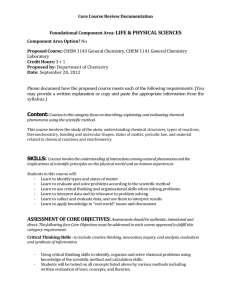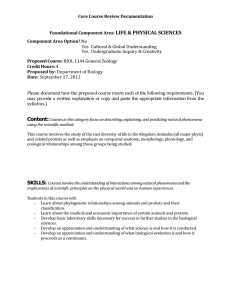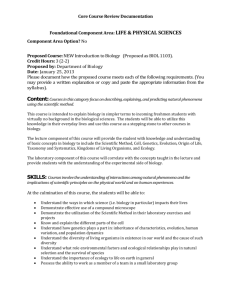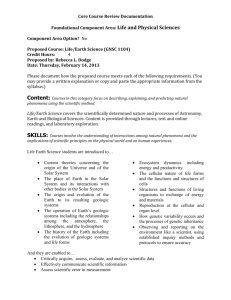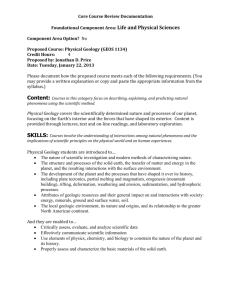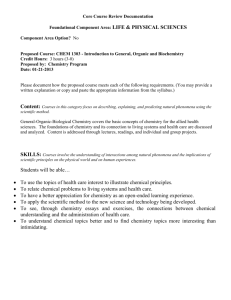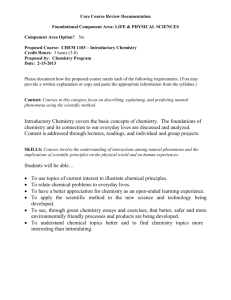method chemistry
advertisement
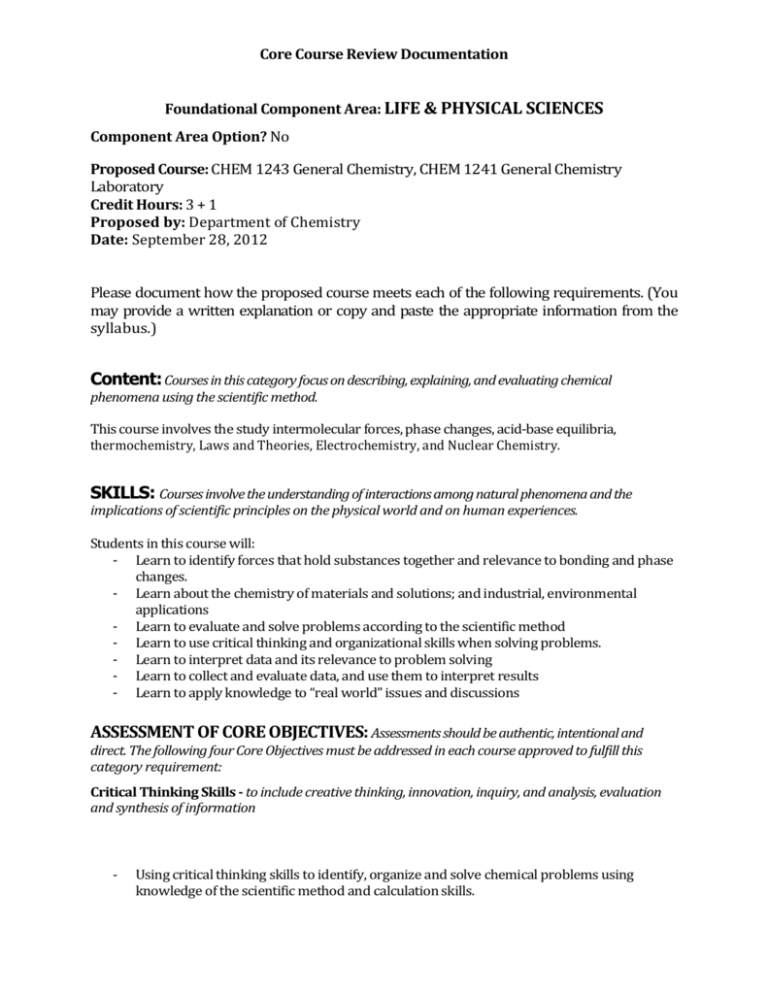
Core Course Review Documentation Foundational Component Area: LIFE & PHYSICAL SCIENCES Component Area Option? No Proposed Course: CHEM 1243 General Chemistry, CHEM 1241 General Chemistry Laboratory Credit Hours: 3 + 1 Proposed by: Department of Chemistry Date: September 28, 2012 Please document how the proposed course meets each of the following requirements. (You may provide a written explanation or copy and paste the appropriate information from the syllabus.) Content: Courses in this category focus on describing, explaining, and evaluating chemical phenomena using the scientific method. This course involves the study intermolecular forces, phase changes, acid-base equilibria, thermochemistry, Laws and Theories, Electrochemistry, and Nuclear Chemistry. SKILLS: Courses involve the understanding of interactions among natural phenomena and the implications of scientific principles on the physical world and on human experiences. Students in this course will: - Learn to identify forces that hold substances together and relevance to bonding and phase changes. - Learn about the chemistry of materials and solutions; and industrial, environmental applications - Learn to evaluate and solve problems according to the scientific method - Learn to use critical thinking and organizational skills when solving problems. - Learn to interpret data and its relevance to problem solving - Learn to collect and evaluate data, and use them to interpret results - Learn to apply knowledge to “real world” issues and discussions ASSESSMENT OF CORE OBJECTIVES: Assessments should be authentic, intentional and direct. The following four Core Objectives must be addressed in each course approved to fulfill this category requirement: Critical Thinking Skills - to include creative thinking, innovation, inquiry, and analysis, evaluation and synthesis of information - Using critical thinking skills to identify, organize and solve chemical problems using knowledge of the scientific method and calculation skills. Core Course Review Documentation - Students will be tested on all concepts listed above by various methods including written evaluation of laws, concepts, and theories. - Using terminology and knowledge in chemistry to write a paper about an industrial chemical or chemical process by identifying and evaluating microscale concepts of atoms/molecules. Students will also identify and evaluate the practical use of this chemical or process. - The Ideal Gas Law Assignment (attached) is a sample of the 3 – 4 assignments that guide students through the critical thinking learning process. The very outline of the assignment guides and teaches the students through a teaching activity using critical thinking skills. The main idea and basic information is given; then the students are asked a series of “basic understanding” types of questions that lead to computations and equation derivation from concepts (deriving equations that are known, but not necessarily known to the student). Students are then asked to apply the concepts learned and equations to simple problems and then to more difficult application questions. These packets are done in class so that the instructor at any point can aid students through the process and do a “mini-lecture” over parts of the material where the class as a whole is having difficulty or misconceptions. This assignment will be assessed using the AACU Value Rubric for Critical Thinking (attached). - Using POGIL (process oriented guided inquiry learning (Hanson, SUNY)) to facilitate group work, thought, and inquiry learning. Three assignments each semester under this format. Communication Skills - to include effective development, interpretation and expression of ideas through written, oral, and visual communication - Using terminology and knowledge in chemistry to write a paper about an industrial chemical or chemical process by identifying and evaluating microscale concepts of atoms/molecules. Students will also identify and evaluate the practical use of this chemical or process. - In lab, students will choose a topic or area in chemistry to give an oral presentation and poster using skills in the scientific method and group collaboration. - These assessment tools will be used to determine if a student has exceeded the “benchmark” status of written, oral, and visual communication as set by the AACU in their Written and Oral Communication VALUE rubrics (attached). This includes numerous aspects of these objectives such as organization, use of sources as support, use of proper scientific language, informative writing, etc. This is the level of expectation of achievement in the sciences for a freshman core class concerning these learning objectives. Core Course Review Documentation - Using POGIL (process oriented guided inquiry learning (Hanson, SUNY)) to facilitate group work, thought, and inquiry learning. Three assignments each semester under this format. Empirical and Quantitative Skills - to include the manipulation and analysis of numerical data or observable facts resulting in informed conclusions - Students will perform exercises involving metric conversions, measurements and calculations of quantitative data while incorporating the scientific method. Grading of the exercise will be used for assessment. - Learn to calculate amounts of substances and equipment needed for experimentation. - This exercise will be used to determine if a student has demonstrated at least the “benchmark” status of quantitative skills as set by the AACU in their Quantitative Literacy VALUE rubric (attached). This includes ability to calculate, interpret numerical data, convert, represent, and communicate numerical data through tables and graphs, and use numerical data to make and support a point. This is the level of expectation of achievement for a freshman core class concerning this learning objective. Teamwork - to include the ability to consider different points of view and to work effectively with others to support a shared purpose or goal - Students will work in groups to construct and present posters. Students will be grouped by random selection to develop fair, unbiased groupings of students. - Students will each evaluate their perceived percentage contribution to the poster by each student in their group as well as themselves. Students will also assess the quality of contribution to the poster by each student in their group as well as themselves. This will incorporate a “self-assessment” component of teamwork (attachment: Student Evaluation of Contribution to Poster Presentation). This individual assessment for teamwork will be incorporated into the grading rubric for poster presentations (attachment: Student Evaluation of Contribution to Poster Presentation). - Students will work in groups while performing observations on several labs. Laboratory teaching assistants will observe students’ group performance over the course of the semester and subjectively assess that performance based on Core Course Review Documentation observations of the students to assign a grade for teamwork at the end of the semester (attachment: TA Evaluation of Student Teamwork in a Course). - These assessment tools will be used to determine if a student has demonstrated at least the “benchmark” status of teamwork as set by the AACU in their Teamwork VALUE rubric (attached). This includes sharing ideas, exhibiting collegiality, and showing responsibility in completing a task by deadline within a group. This is the level of expectation of achievement for a freshman core class concerning this learning objective. ADDITIONAL INFORMATION: Provide any additional information supporting course inclusion in the core (optional). PLEASE ATTACH THE FOLLOWING 1. 2. 3. 4. 5. Syllabus Assessment for Critical Thinking Skills Assessment for Communication Skills Assessment for Empirical & Quantitative Skills Assessment for Teamwork
